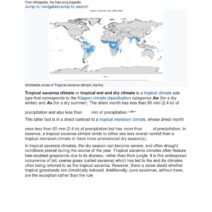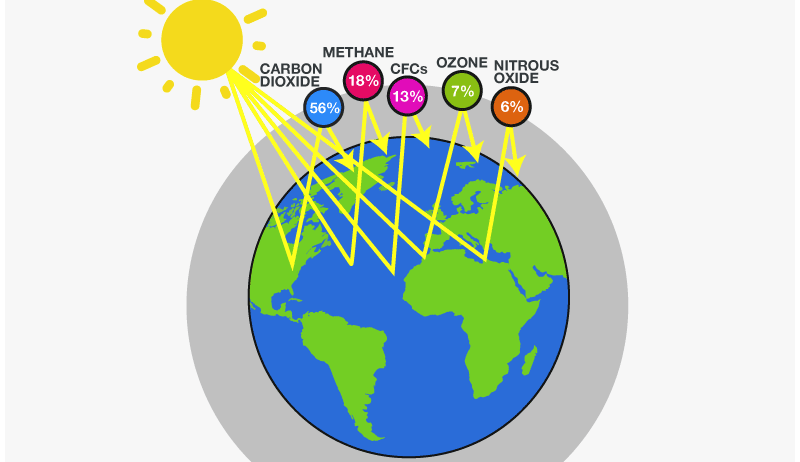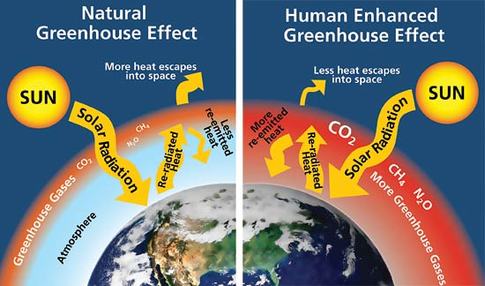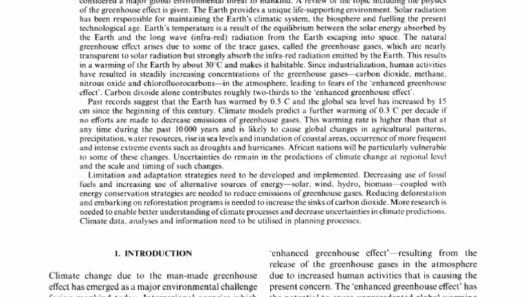The delicate balance of Earth’s climate system is intricately woven together by a multitude of factors, one of which is the process known as the greenhouse effect. The interplay of various gases within our atmosphere plays a monumental role in maintaining this balance, akin to a symphony where each instrument contributes to the overall harmony. Yet, as our planet warms, this symphony becomes increasingly dissonant. Understanding how gases amplify the greenhouse effect is essential to unraveling the complexities of climate change and forging a path toward a sustainable future.
The Chemistry of Sequestration: How Gases Trap Heat
At the heart of the greenhouse effect lies a chemical coalition of gases, primarily carbon dioxide (CO2), methane (CH4), nitrous oxide (N2O), and water vapor (H2O). These substances function as a thermal blanket enveloping the Earth. When sunlight reaches our planet, it is absorbed by the surface and transformed into infrared radiation, or heat. This heat then attempts to escape back into space, yet the greenhouse gases act as barriers, absorbing and re-radiating this energy. The result? A gradual rise in global temperatures.
Consider a greenhouse filled with flourishing plants. Sunlight pours through the glass, warming the interior while trapping heat, allowing life to thrive. Similarly, the atmospheric gases create a conducive environment for life on Earth, but excessive concentrations inevitably lead to overheating. It is an intricate balancing act where some heat retention is vital for maintaining habitable conditions, yet too much leads to catastrophic consequences.
Chasing Shadows: The Role of Different Greenhouse Gases
Not all gases are created equal in their capacity to contribute to the greenhouse effect. While CO2 is the most prevalent greenhouse gas, methane is an even more potent player, albeit in smaller amounts. Methane is over 25 times more effective than CO2 at trapping heat in the atmosphere over a 100-year period. This discrepancy is vital to grasp, especially as it highlights the urgent need to address methane emissions stemming from agriculture, waste management, and fossil fuel extraction.
Nitrous oxide, while less abundant, boasts an even higher global warming potential. Its release is primarily linked to agricultural practices, particularly the use of synthetic fertilizers. Water vapor, although the most abundant greenhouse gas, has a unique role. Unlike its counterparts that stem from human activities, water vapor is a feedback mechanism; as temperatures rise, the atmosphere can hold more moisture, perpetuating the cycle of warming.
Envision a team of athletes in a relay race, each passing the baton to the next. Each greenhouse gas acts like a runner, with CO2 setting the pace while methane and nitrous oxide surge ahead, speeding up the process. The collaborative yet competitive nature of these gases dictates the urgency of addressing climate change and strategizing for a sustainable future.
The Vicious Cycle: Feedback Mechanisms Accelerating Warming
The greenhouse effect instigates several feedback loops that aggravate warming in a precarious cycle. One of the most significant is the albedo effect—reflectivity of the Earth’s surface. As ice caps and glaciers melt due to rising temperatures, they expose darker ocean waters or land, which absorb more heat rather than reflect it away. This phenomenon underscores the interconnectedness of Earth’s systems—each component influences another, creating a ripple effect that escalates warming.
Additionally, the scenarios are further complicated by forest ecosystems. Trees and vegetation sequester carbon dioxide, but as forests become stressed from higher temperatures and shifting climatic zones, their ability to absorb CO2 diminishes. Instead of acting as repositories of carbon, these once-thriving ecosystems become sources of greenhouse gases. The imagery of a tree’s branches, once a refuge for countless species, now becoming a contributor to the very problem it was part of solving, paints a sorrowful picture of environmental degradation.
In a world where human influence complicates natural processes, recognizing the myriad of interactions among greenhouse gases and their feedback mechanisms is crucial. The delicate threads connecting these elements reveal the intricate tapestry of climatic influences and our inextricable link to the Earth’s health.
Imminent Action: Mitigating the Greenhouse Gas Dilemma
In light of the profound impact gases have on the greenhouse effect, immediate action is paramount. Mitigating strategies must encompass reducing emissions, fostering renewable energy technologies, and enhancing carbon sink initiatives through reforestation and sustainable land management. Shifting societal mindset—from individual consumption choices to systemic changes in energy production—will be essential in combating this crisis.
Investigating policies such as carbon pricing and emissions trading systems presents pathways for reducing greenhouse gas concentrations. Education and awareness campaigns can mobilize public sentiment, transforming lifestyle choices and policies alike. The symphony of the atmosphere can only be restored when collective efforts harmonize to play their part in addressing climate change.
In conclusion, the interplay of gases in Earth’s heat balance reveals a complex narrative filled with both threat and opportunity. As the consequences of climate change loom ever larger, understanding the unique roles each greenhouse gas plays allows us to tackle the issues at hand with renewed vigor. The urgency is palpable, and the actions we choose to take today will reverberate through time, shaping the world for generations to come.








